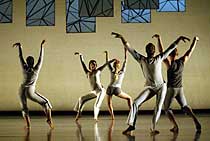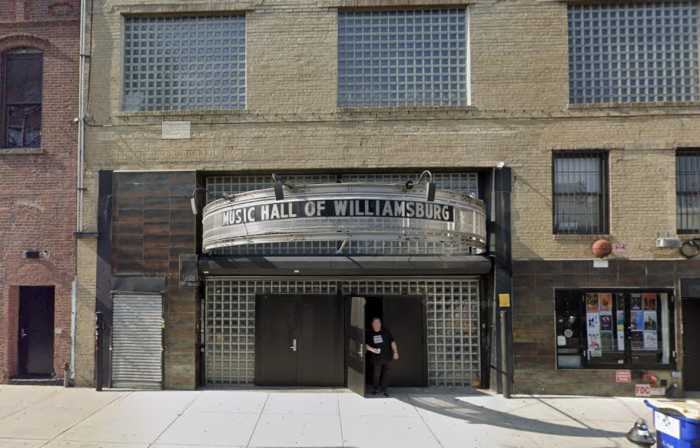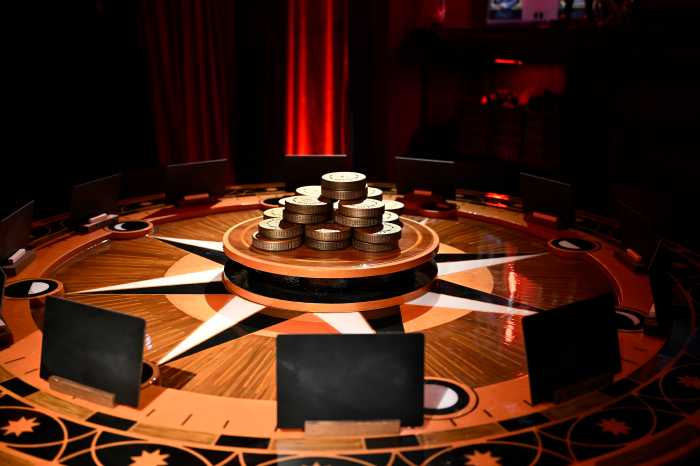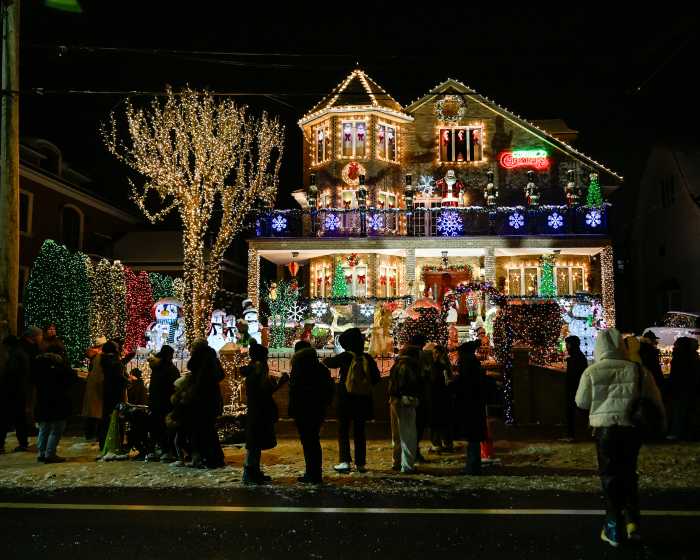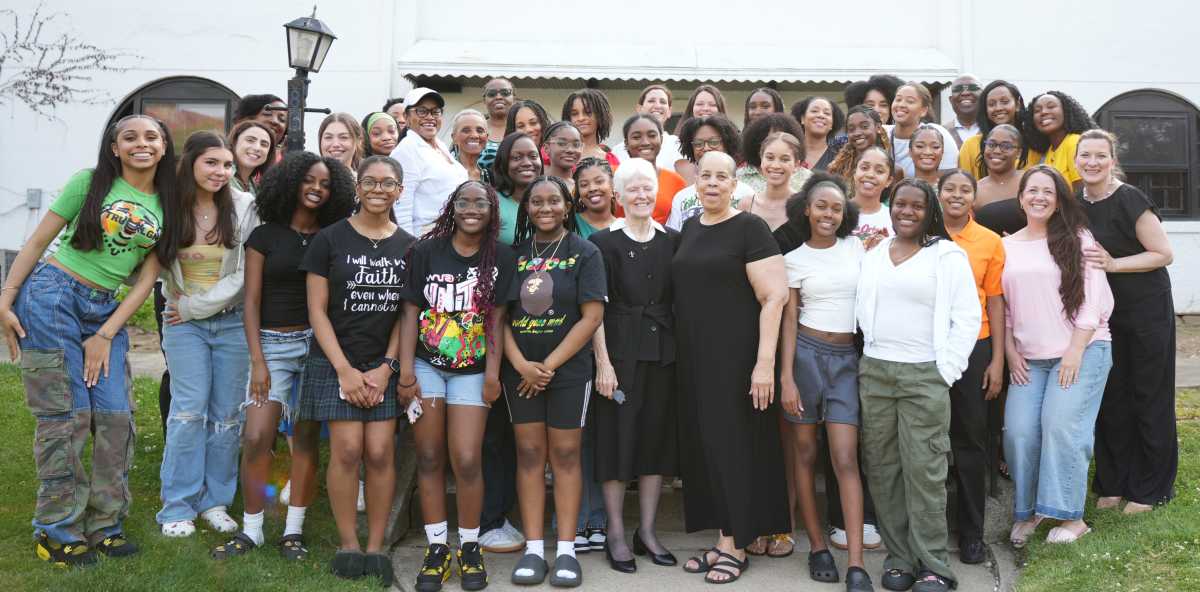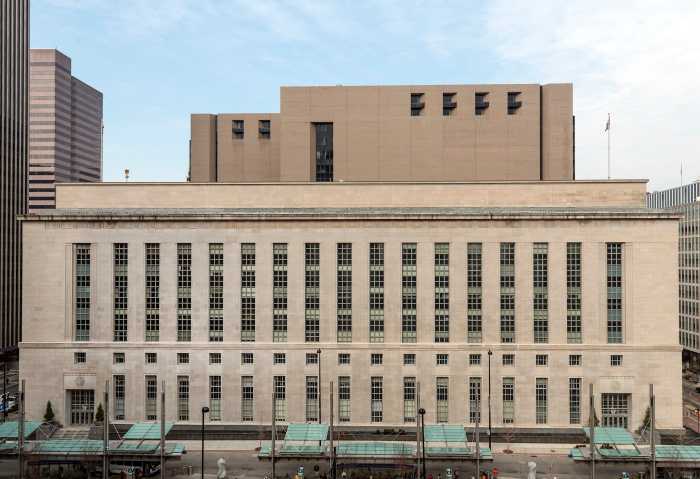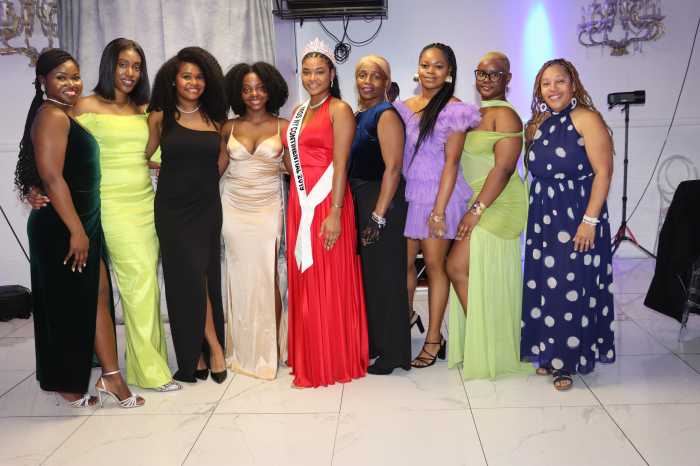Fifteen dancers enter and exit through
exposed lighting towers standing at the side of the Brooklyn
Academy of Music’s opera house stage like wings. Glowing vertical
panels hang above, marked with designer Stephen Hendee’s ruled
geometry. The high-tech set is the stage for Mark Morris’ latest
dance, "Violet Cavern," which premiered at BAM on June
8.
This dance could be described as geologic with its passages of
very slow movement, and in the grandiose feeling of the music
and of the dance – a confluent inspiration. The triumphant epic
features lyrical details in strains of tinkling piano and softly
screeching strings.
Pianist Ethan Iverson, former music director of the Mark Morris
Dance Group (MMDG), continues the relationship now; he composed
the score of "Violet Cavern." The new creation was
only weeks ago titled "Seven Visions" for the seven
movements of Iverson’s score. Described as "renegade"
on the band’s Columbia Records Web site, Iverson’s fusion jazz
trio, The Bad Plus, played "Violet Cavern" live for
the dance of the same name. The piece is wholly engaging and
danceable for the Morris Group. In other hands, the challenge
could be daunting.
The music’s ever-changing character variegates the dance. In
the 50-minute duration of the performance, spectators are transported
to an eerie, futuristic setting. Michael Chybowski’s spectacular
lighting scheme includes washes of solid red, violet or green
that break up the dance’s moody phrases of different tempos and
energy levels.
The dance sometimes proceeds at a glacial pace in sitting and
prone positions that lend themselves to low levels of mobility;
but the dancers are not relaxed. They’re stretched into stiff
extensions or actually moving across the floor in improbable
and seemingly stationary positions.
A dancer walks holding the hands of two others lying parallel,
appearing to effortlessly drag them. At the same time, the two
seem to glide of their own volition – walking the walker. The
ambiguous transit creates an ethereal quality where it seems
possible that the stage itself is moving. Reflections on the
shiny floor also have the effect of levitating the dancers. A
seeming weightlessness is achieved that brings their supported
leaps to greatest heights.
When the group of 15 is onstage, their fluid movement can seem
patterned on that of a flock of starlings. Arms wave as only
those of the finest dancers can. But this peaceful unison is
broken by a startlingly violent stunt in which partners are thrown
to the ground. A very fast section reels almost out of control.
It has the feel of an improvised jam that’s a bit off kilter.
Even Joe Bowie, who steps like a natural jazz dancer seems to
struggle with this super-quick sequence.
Winding up, the troupe spins like tops. Black stripes down the
sides of their gray bicycle shorts or pants wend around the dancers;
most of them drop to the floor but two keep on. The music has
stopped and the sound of four bare feet squeaking on the waxed
flooring is a last humble, audible gesture.
The June 8 program opened with "All Fours." In that
work, eight dancers are in black dress while Craig Beisecker
and Bradon McDonald, Julie Worden and Marjorie Folkman stand
out for duets in off-white colors in two movements of Bartok’s
String Quartet No. 4.
Nicole Pearce’s lighting breaks and ends dance phrases with flashes
of red fill.
Dancers gesture listening, prayer or surrender, balancing on
each other’s knees for height. Worden and Folkman fly, carried
across the stage by Bowie and Charlton Boyd. The men in black
disappear into the dark set. They touch each other’s mouths as
if after love or to quell strong emotion. In a lonesome end to
one movement, McDonald collapses onstage after beseeching to
a departing friend or lover. The reverent gestures are integral
to the dance.
"All Fours" brings out a contemporary edge to modern
Hungarian composer Bartok. The composer and choreographer share
an interest in folk forms and they are integrated into "All
Fours." But the piece, performed live by MMDG’s own resident
quartet, features false starts characteristic of our postmodern
era.
The men are rough and ready, and the women are statuesque but
bold in aerial acrobatics. Overall, the dancers’ enactment of
preparedness and response is refreshing and invokes the trust
of the audience – response to a world in which loss is an everyday
reality. They finish in an asymmetric formation with the off-white
clad quartet on top but facing upstage.
Both dances have an aura of triumph; the aggression in "Violet"
seems a cruel necessity. The triumph seems more an embrace of
life. Understated miming gestures reveal traditional themes of
love and loss in this pure dance idiom. While integrated jazzy
movements bring mixed results in "Violet Caverns,"
Mark Morris Dance Group meets the challenges of the music with
a vengeance in both dances with innovative movement.
The Mark Morris Dance Group will perform "My Party,"
"Going Away Party" and "Grand Duo" at Celebrate
Brooklyn on July 17. The performance will take place in the Prospect
Park Bandshell. Enter at Prospect Park West and Ninth Street.
Suggested admission is $3. For more information, call (718) 855-7882.


